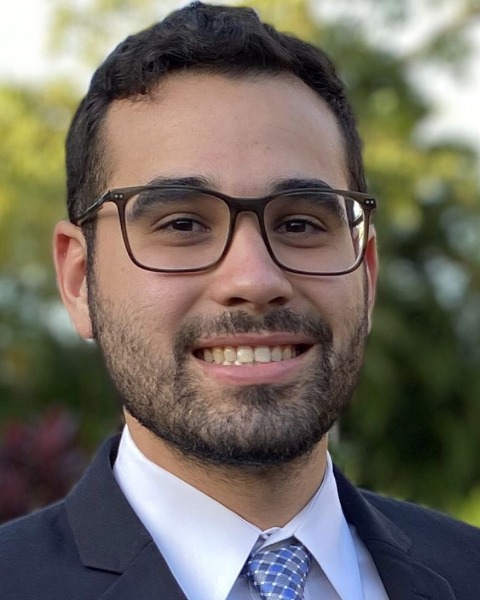Back
Poster, Podium & Video Sessions
Moderated Poster
MP46: Penile & Testicular Cancer I
MP46-18: Human Papillomavirus Mediated Penile Cancer Overexpress NOTCH2 and JAG1
Sunday, May 15, 2022
1:00 PM – 2:15 PM
Location: Room 222
Carlos Rivera-López*, San Juan , Puerto Rico, María Sánchez-Vázquez, San Juan, Puerto Rico, Andrés Hernández-González, San Juan , Puerto Rico, María Marcos-Martínez, Jasmine Figueroa-Díaz, Josue Pérez-Santiago, San Juan, Puerto Rico, Xin Lu, Notre Dame , IN, Jad Chahoud, Tampa , FL, Niki Zacharias, Houston, TX, Antonio Puras-Baez, San Juan , Puerto Rico, Curtis Pettaway, Houston, TX, Magaly Martínez-Ferrer, San Juan, Puerto Rico

Carlos A. Rivera Lopez, MD
University of Puerto Rico
Poster Presenter(s)
Introduction: The incidence and mortality of penile cancer (PeCa) in Puerto Rico is significantly higher when compared to the USA. Infection with human papillomavirus (HPV) has been identified as a risk factor for an average of 48% of PeCa cases. Understanding the role of genes and pathways that are differentially expressed in HPV+ vs. HPV- PeCa could aid development of novel therapeutic agents to reduce mortality from advanced penile cancer. We identified Notch signaling among the most enriched pathways at the transcriptomic level for HPV+ PeCa. Therefore, the objective of this study is to validate the enrichment of Notch signaling in HPV+ penile cancer.
Methods: PeCa fresh tissue was obtained from surgery cases (n=28) at the University of Puerto Rico. Tumors were characterized based on the histologic type, histologic grade, stage, p16 status and age. HPV genotyping was performed in all samples using INNO-LiPA HPV Genotyping. Gene expression profile was measured using the Affymetrix GeneChip® Human Gene 2.0 array. To confirm the expression of JAG1 and NOTCH2 we performed immunohistochemistry analysis in HPV+ and HPV- PeCa tumors. Univariate and multivariate analysis was performed.
Results: A total of 28 patients (11 HPV+ and 17 HPV-) aged 46 to 81 (median 64) years old were used for microarray analysis. Seventy seven percent of patients had a histologic grade 1, 11.5% grade 2 and 11.5% grade 3 tumors. Expression of JAG1 was significantly higher in HPV+ PeCa tumors (5.00 vs. 6.62, p<0.01) while expression of NOTCH2 trended to be higher (3.87 vs. 4.60, p=0.07) in HPV+ tumors. JAG1 and NOTCH2 were significantly higher in HPV+ tumors after adjusting for histologic type, grade, stage, p16 status and age. In the multivariate regression analysis, expression of JAG1 remained significantly higher in HPV+ tumors (p < 0.01) and showed a trend for an increased expression in tumors with metastasis to lymph nodes (p=0.06) (Model R2=0.37, p<0.01). Expression of NOTCH2 was significantly higher in HPV+ tumors (p=0.02) and a higher expression level in tumors with metastasis to lymph nodes (p=0.05) (Model R2=0.24, p=0.02). Immunohistochemistry analysis of HPV+ and HPV- PeCa tissues confirmed that JAG1 and NOTCH2 were significantly over expressed in HPV+ tumors (p < 0.05).
Conclusions: NOTCH2 and JAG1 expression was validated to be over expressed in HPV+ PeCa tumors when compared to HPV- PeCa tumors. This data provides evidence to support targeting this pathway as a potential approach to specifically impairing the progression of HPV+ PeCa.
Source of Funding: 1. NIH/NCI: U54 CA096297/CA096300
2. Comprehensive Cancer Center of the University of Puerto Rico
Methods: PeCa fresh tissue was obtained from surgery cases (n=28) at the University of Puerto Rico. Tumors were characterized based on the histologic type, histologic grade, stage, p16 status and age. HPV genotyping was performed in all samples using INNO-LiPA HPV Genotyping. Gene expression profile was measured using the Affymetrix GeneChip® Human Gene 2.0 array. To confirm the expression of JAG1 and NOTCH2 we performed immunohistochemistry analysis in HPV+ and HPV- PeCa tumors. Univariate and multivariate analysis was performed.
Results: A total of 28 patients (11 HPV+ and 17 HPV-) aged 46 to 81 (median 64) years old were used for microarray analysis. Seventy seven percent of patients had a histologic grade 1, 11.5% grade 2 and 11.5% grade 3 tumors. Expression of JAG1 was significantly higher in HPV+ PeCa tumors (5.00 vs. 6.62, p<0.01) while expression of NOTCH2 trended to be higher (3.87 vs. 4.60, p=0.07) in HPV+ tumors. JAG1 and NOTCH2 were significantly higher in HPV+ tumors after adjusting for histologic type, grade, stage, p16 status and age. In the multivariate regression analysis, expression of JAG1 remained significantly higher in HPV+ tumors (p < 0.01) and showed a trend for an increased expression in tumors with metastasis to lymph nodes (p=0.06) (Model R2=0.37, p<0.01). Expression of NOTCH2 was significantly higher in HPV+ tumors (p=0.02) and a higher expression level in tumors with metastasis to lymph nodes (p=0.05) (Model R2=0.24, p=0.02). Immunohistochemistry analysis of HPV+ and HPV- PeCa tissues confirmed that JAG1 and NOTCH2 were significantly over expressed in HPV+ tumors (p < 0.05).
Conclusions: NOTCH2 and JAG1 expression was validated to be over expressed in HPV+ PeCa tumors when compared to HPV- PeCa tumors. This data provides evidence to support targeting this pathway as a potential approach to specifically impairing the progression of HPV+ PeCa.
Source of Funding: 1. NIH/NCI: U54 CA096297/CA096300
2. Comprehensive Cancer Center of the University of Puerto Rico

.jpg)
.jpg)